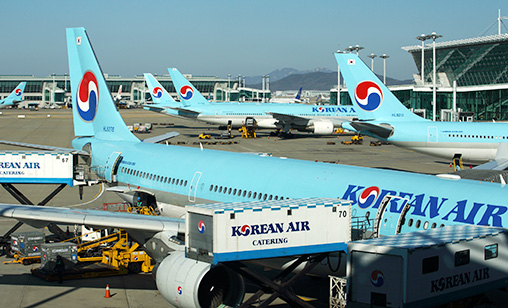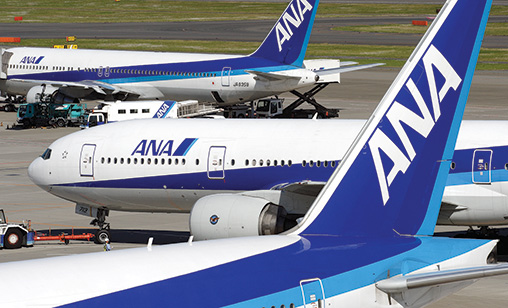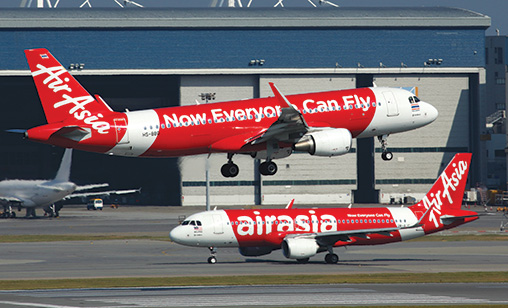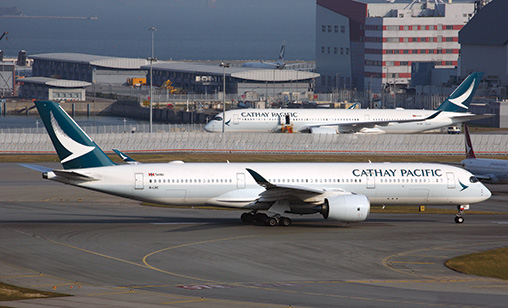News Backgrounder
More Asia-Pacific carriers detail ruin of pandemic on their bottom lines
February 1st 2021
Some of the Asia-Pacific’s largest airlines are cautiously optimistic that market conditions will improve later this year. Read More » Such sentiments were evident in the latest financial results from Korean Air (KAL) and SIA Group, published this past month, although All Nippon Airways (ANA) and Japan Airlines (JAL) were more guarded in their outlooks.
 |
 |
Airlines remained mired in loss-making territory from the ongoing impact of the coronavirus pandemic, but there was hope the rollout of COVID-19 vaccines would allow the borders to reopen to stem the flow of red ink.
Given it has no domestic market, SIA Group - Singapore Airlines, SilkAir and Scoot - has been particularly hard hit by travel restrictions imposed to contain COVID-19.
Nonetheless, the group’s three carriers improved passenger numbers by 26%, to 195,000 in the three months to December 31, 2020, from 155,000 in the quarter to September 30.
Despite the quarter-on-quarter growth passengers flown declined 98.1%, from 10.1 million a year earlier. The airline group had 64 passenger aircraft operating at the end of December 2020 with 24 of the fleet flying cargo-only services. One hundred and twenty three of the group’s aircraft were parked.
“In line with Singapore’s progressive re-opening, the group expects to see a measured expansion of the passenger network over the coming months,” SIA Group said in its latest financial results, which revealed a net loss of S$141.8 million (US$107 million) for the three months to last December 31 compared with a net profit of S$314.8 million in the previous December.
“Based on our current schedules, as of end-April 2021, the group’s total passenger capacity is expected to be 25% of pre-COVID levels. We expect to serve around 45% of the points we flew before the crisis,” the airline said.
“We will continue to monitor the status of travel restrictions and adjust our capacity accordingly to meet the traffic demand.”
For the three months to December 13, group capacity, measured by available seat kilometres (ASK), was 14.2% of the same quarter in 2019.
Five days after the release of its latest results, the company informed the Singapore Exchange (SGX) it had reached agreements with Airbus and Boeing to defer aircraft due to be delivered between 2021 and 2023 to later years.
Updated projections are that the company will outlay S$20 billion in capital expenditure in the five financial years to fiscal 2025, down 18% of its previous forecast of S$24.4 billion.
 |
An order for 14 787-10s was converted to 11 777-9s in response to “changes in its projected long-term fleet needs” beyond the fiscal 2026 financial year, the airline group said.
The revised order book is 35 A320 family aircraft, 15 A350-900s, 31 737 MAXs, 20 787 family planes and 31 777-9s.
“The agreements with Airbus and Boeing are a key plank of our strategy to navigate the disruptions caused by the COVID-19 pandemic,” SIA Group CEO, Goh Choon Phong, said in a statement.
“They allow us to defer capital expenditure and recalibrate the rate we add capacity, aligning both with the projected recovery trajectory for international air travel.”
KOREAN AIR POSTS 2020 OPERATING PROFIT
In early February, Korean Air (KAL) announced an operating profit on earnings before interest and tax (EBIT), of 283.3 billion won (US$258 million) for calendar 2020, down 17% from 286 billion won a year ago.
The Seoul -headquartered carrier said the result was underpinned by the strong performance of its cargo business and efforts to cut costs amid the devastating impact of the coronavirus pandemic.
 |
 |
KAL president, Keehong Woo, said the SkyTeam alliance member boosted its 2020 cargo operations to meet demand for medical supplies, particularly COVID-19 test kits and masks.
Reduced global air freight capacity from the grounding of a large number of passenger aircraft coupled with cargo demand holding firm had led to strong air cargo rates.
“We increased cargo capacity by converting passenger jets into freighters. We’ve done well to keep our cargo network strong and active,” Woo said.
KAL noted the fragile nature of passenger demand in its annual results presentation. Signs of recovery on Jeju routes had “rapidly declined” in December after the country’s regulator strengthened social distancing rules.
More immediately, the passenger demand decline from COVID-19 continued, but it was hoped “demand would recover gradually after full-scale vaccination in the second half of 2021,” the carrier said.
In March, KAL is scheduled to issue 3.3 trillion won in new shares to improve its balance sheet and boost liquidity as well as prepare for its planned takeover of Asiana Airlines.
Purchase of South Korea’s second international carrier was “inevitable to enhance the market’s competitiveness and minimise the injection of public funds”, the airline said.
KAL’s net loss narrowed to 228.1 billion won in calendar 2020, from a 568.7 billion won net loss in the earlier year.
JAPAN’S BIG TWO CARRIERS CAUTIOUS AS NEW STATE OF EMERGENCY PUT INTO FORCE
Japan Airlines (JAL) posted a net loss of 212.7 billion yen (US$2 billion) for the nine months to December 31, 2020, compared with net profit of 74.8 billion yen in the previous 12 months.
The airline group downgraded its full-year forecast in response to the latest booking data for the remaining months of its fiscal year. Japan declared a State of Emergency for the second time on January 8. JAL said the market had not improved as it had expected.
 |
In a regulatory filing on February 1, JAL said it was in line to post a net loss of 300 billion yen for the 12 months to March 31, 2021, a decline from an October 2020 forecast of a 240 billion to 270 billion yen net loss.
“At present, it is difficult to foresee the recovery of demand while the global spread of COVID-19 shows no sign of slowdown,” JAL said in its third quarter results.
“The recovery of international and domestic passenger demand will [likely] be affected by border closure and travel restrictions by governments. Uncertainty on our further business performances is expected to persist,” JAL said.
Previously, JAL had forecast international passenger demand would recover to 30%-40% of pre-COVID-19 levels by year end. Instead, it is predicted to be about 5% of pre-pandemic levels.
Domestic demand is calculated to be about 20% of last year’s levels to March 31, JAL said. In October, the oneworld alliance member was looking forward to a domestic market increasing to 80% of 2019 figures.
It was a similar story at ANA HOLDINGS INC, the parent company of JAL’s rival, All Nippon Airways (ANA). It posted a net loss of 309.6 billion yen (US$2.9 billion) for the nine months to December 31, compared with a net profit of 86.4 billion yen for the same months in 2019.
The company said In a regulatory filing on January 29, its financial forecasts were unchanged from October, with a net loss of 510 billion yen predicted for its full fiscal year, to March 31.
While its guidance remained unchanged, ANA HOLDINGS INC said there had been changes in the market response to the latest coronavirus developments.
“At the end of Q2, we expected passenger demand to recover to about 50% of pre-COVID-19 times on international routes and about 70% on domestic routes by the end of the fiscal year,” it said.
“Now we believe it will be difficult to recover due to sluggish demand caused by the second declaration of a [Japan’s] State of Emergency.
“However, load factors on domestic flights in October and November exceeded 60%, which confirmed demand would recover rapidly after the spread of COVID-19 subsides substantially.”
Asia-Pacific aviation will learn more about the state of the market on February 25, when Air New Zealand and the Qantas Group announce their 2020-20/21 first half numbers followed by Cathay Pacific Group’s results on March 10.